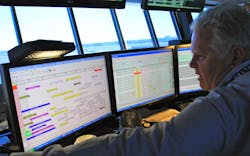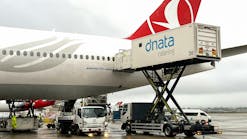New Strategies and Solutions to Help Meet Ground Handling Challenges
Airlines are under considerable pressure to consistently achieve on-time performance, while minimizing operational costs. It is estimated that for a large airline adding just five minutes to aircraft ground time can cost the airline up to $35 million (USD) annually.
A deciding factor in meeting on-time performance goals is the efficiency of the airlines’ ground handling operations.
The reality is airlines and ground handlers face major challenges relating to ground handling. From the inefficiencies associated with multiple ground handlers, suboptimal airport designs and a lack of standardized procedures, to unexpected, costly aircraft ground damage and ineffective resource management, it is clear that ground handling requires better solutions.
Many airlines are attempting to address these challenges by outsourcing their ground handling to third parties. The International Air Transport Association’s (IATA) data suggests that more than 50 percent of all ground handling is managed by the more than 1,000 ground handlers worldwide.
Other measures airlines are taking include investing in advanced technologies, and embarking on robust employee training programs.
There is also a heightened awareness that ground handling services cannot be viewed as commodities, but rather essential core services for which value and not just price must be emphasized. It’s important that all parties understand how pervasive challenges have been driving the ground handling industry’s growth, as well as new measures to optimize ground handling processes.
Ground Handling Industry Growth
Given the aforementioned challenges, there has been no shortage of growth for the ground handling industry. For 2016, Visiongain Ltd. valued the airport ground handling services market at $54 million (USD) with growth rates projected to be strong over the next decade.
Market research conducted by the analysts at Technavio projects a compound annual growth rate of approximately 6 percent by 2020 for the global aircraft ground handling system market.
To further illustrate the magnitude of the ground handling market and its growth trajectory, GM Insights projected the aircraft ground handling system market size to exceed $160 million (USD) by 2022.
This encompasses aircraft, cargo and passenger handling applications. Suffice it to say, that it is a booming industry despite, or perhaps because of, the many challenges faced.
The Challenges
Let’s start with the spiraling downward profit margins for ground handlers. Increasing competition in the sector has been forcing prices down and further commoditizing vital ground handling services.
Currently, leading ground handlers are working with an estimated 5 percent return on their sales. Recognizing this, astute airlines are rejecting the commodity view, and instead opting to work with the handlers to negotiate the best service packages, not just the best price.
After all, the best outsourcing models rely on a “partnership” approach where there is a shared, vested interest to deliver the highest benefit/cost ratio.
Besides the profit margins, there’s the apron congestion associated with so many handlers operating in a single airport. This has contributed to increased demand for ground support equipment in tandem with decreased productivity.
Some airports are looking at ways to pool equipment and perhaps related labor resources for multiple handlers in order to reduce the costs associated with both and improve productivity.
Regarding labor, there are the usual factors influencing productivity such as staff knowledge and skills, communication, equipment design, safety and overall employee job satisfaction.
The absence of a fixed model for ground handling, coupled with regulations that vary across nations, compounds the challenges associated with staff performance. Staff performance problems are most often revealed in incidents related to unexpected disruptions such as aircraft ground damage, accidents, equipment failures, etc.
Given the range of challenges airlines face relating to ground handling, multi-faceted approaches are needed, including better safety audits, training and new technologies.
The Solutions
Recognition that a global standard for ground handling policies and procedures would be beneficial, IATA started tackling the issue as early as 2008 when it first introduced its IATA Safety Audit for Ground Operations (ISAGO) model.
More recently, the organization announced a new model encompassing a new schedule for ISAGO audits to begin in January 2018 but with the same goals of improved ground safety, auditor training/qualification and audit efficiency, as well as the elimination of duplicate audits by air operators.
In additional to the audits, there is heightened focus on safety in ground handling, a central theme in the National Air Transportation Association’s (NATA) Ground Handling Safety Symposium held this past September.
IATA estimates that the aviation industry would save $4 billion (USD) annually by improving safety and reducing damage to aircraft and ground vehicles. If you consider that there are more than 200 steps required to prepare an aircraft on the ground for its next take-off, it’s not too hard to understand that accidents and damage to aircraft and ground equipment could easily occur in the absence of the right safety management system (SMS).
SMS aspects of ground handling systems are designed to reduce ground handling incidents, promote safe and correct use of ground handling vehicles, establish a safety culture among staff and ensure compliance to safety regulations. They identify risks and establish processes to mitigate them.
As a result, modern GSE management consists of mechanisms like geo-fencing and license and training management to ensure that only qualified staff is able to, for example, start certain vehicles.
Powerful benchmarking and reporting measures foster a culture of continuous improvement for all parties involved in ground handling from the aircraft operators and ground handlers to fuelers, baggage handlers and caterers.
Software solutions designed specifically to improve ground handling operations are another weapon in the airlines’ toolbox. There are a host of sophisticated software solutions targeting all facets of ground handling processes with the intent to drive greater efficiencies and positively impact costs through improved performance and optimized resource planning.
With the emphasis on seamless, real-time exchange of information, workforce management solutions provide:
- Effective staff task allocations and overall workforce management.
- Monitoring and reporting of turnaround status.
- Efficient management of unexpected contingencies/disruptions.
Key to these solutions is the emphasis on a balance between meeting demands on the ground, without compromising workforce morale and motivation. The last thing an airline and ground handlers want is to drive optimization at the cost of employees’ best interests.
Incorporating features for tactical and operational planning, flexible workforce deployment, intuitive user interfaces and relevant reporting, these advanced solutions strike the right balance between scheduling demands, resource optimization, productivity and employee motivation.
When it comes to turnaround management, today’s solutions strive to reduce turnaround delays and related financial repercussions, while also improving passenger service quality.
The emphasis is on fully-transparent, real-time data exchanges whereby information relating to all major clearance activities, passenger connections, baggage transfer, loading operations and other turnaround related activities can be monitored instantly.
The solutions effect real-time reporting of potential bottlenecks detected based on the continuous monitoring of flight and handling details. When a bottleneck or other problem is identified, it is reported in real-time through mobile devices and for interception and management before it can trigger a delay. The process at the center of the possible delay is detected and reported in conjunction with recommended actions so that preemptive measures can be chosen.
Integrated cost-based decision support, not only at the local airport, but network-wide, is also provided by the solution and weighs such factors as inflight fuel consumption, rebooking and delay costs.
Line maintenance tasks executed during typical turnaround periods are fully supported by today’s advanced line maintenance software solutions which are seamlessly integrated into an airline’s existing MRO system. These solutions deliver decision-making support, from planning and rostering to operations. They provide automatic determination of tasks with assignments delivered to employees via their mobile devices.
Using the solutions, employees all have the information at their fingertips while task statuses are readily available. Performance monitoring of all pertinent processes are recorded to facilitate evaluations, quality control and billing. The most sophisticated of these solutions also keep track of all open minimum equipment list (MEL) repair orders and automatically assigns them to available employees for efficient handling and lower operating costs by keeping the MEL list as short as possible.
Ramp services also are benefitting from leading-edge, optimization solutions. They are supporting dispatchers with real-time, continuously updated information regarding resources and staff workloads.
Just as with maintenance processes, the software automatically determines tasks and staff assignments applying rule-based task specifications and the required skill-set. Web-based communication facilitates real-time transmission of job-related activities to employees via their tablets and smartphones.
These features, coupled with performance monitoring, provide airlines with enhanced resource utilization, planning, communication, service quality and compliance, plus the ability to bill for additional tasks that have been provided.
Where ground support equipment (GSE) management is concerned, optimization solutions provide intelligence far beyond the location and status of equipment.
Instead, these robust solutions offer detailed information that promotes the more efficient control and management of GSE. Real-time fleet monitoring encompassing GSE position, operational status and condition is provided, as well as a well-designed airport map reflecting conveying data visualization within a geographical context.
Other key features of an advanced GSE management solution are:
- Automatic maintenance prediction based on operating hours.
- Detection and troubleshooting of any GSE problems.
- Automatic creation of a fuel task and its progress, and the optimal time window for such tasks.
Focus on Best Practices
Ground handling processes will continue to challenge the airlines and ground handlers, however, there have been significant strides made in measures to help ease their burden.
The implementation of a holistic view on the turnaround processes and emphasis on best practices are making a difference. These measures applied in concert with the application of advanced optimization solutions are helping the airlines and their ground handling partners improve performance levels, optimize resources and manage their operating costs.
There’s no denying the impact ground handling operations have on the passengers’ ultimate experience. All of those preparation processes from an aircraft’s time of arrival to its next departure and their associated time and cost factors weigh heavy on an airline’s ability to compete. Being proactive in terms of ground handling strategies and deploying holistic solutions that afford a better competitive edge is essential for an airline’s future.





